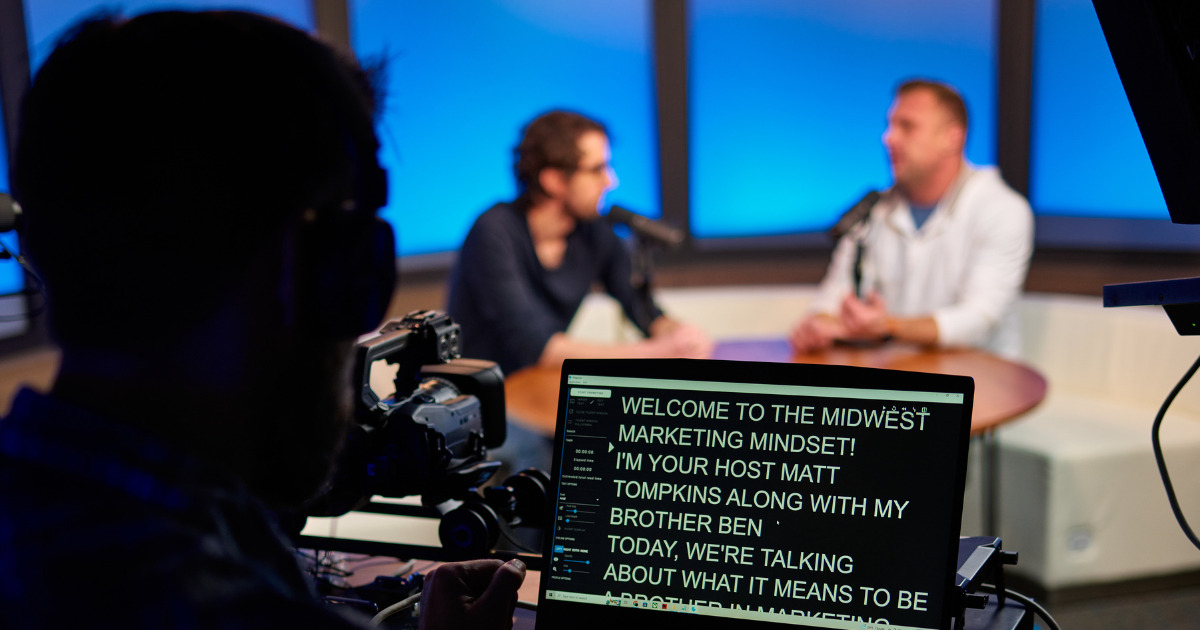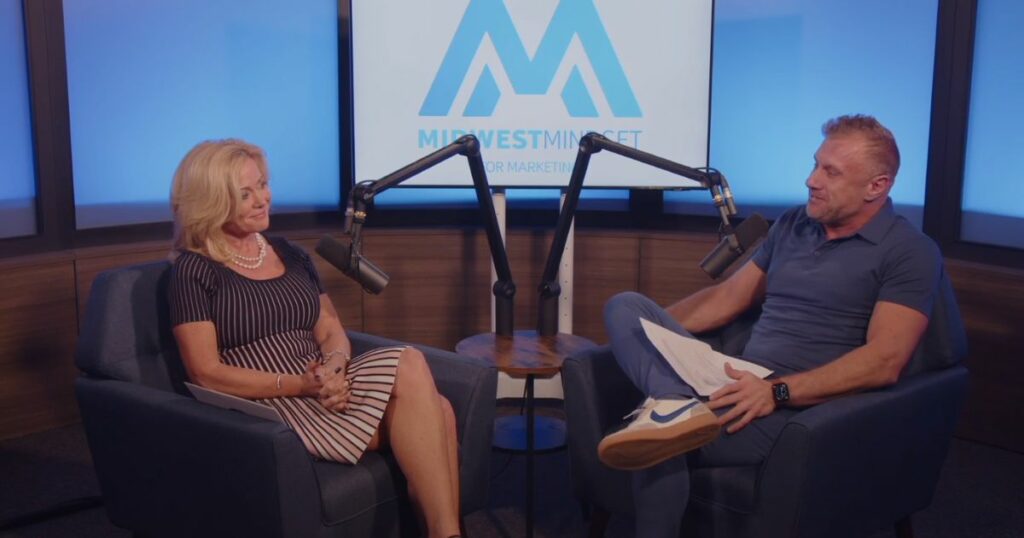Healthy Website Transcript
Season 2: Episode 4
This is a full written Transcription for the episode: Is Your Website Hurting Your Business? of the Midwest Mindset podcast.

Full Written Transcript of The Episode
Matt Tompkins: Is your website hurting your business? That is not an easy question for us entrepreneurs to ask ourselves, but for the vast majority of small businesses, the answer is yes. Or at the very least, your website isn’t helping your business. Your website is literally your digital storefront.
And the days of simply having a website that’s just up and exists online, it’s not enough anymore. Even having a website that looks great, that isn’t enough either. Not in today’s search engine optimization world. It doesn’t matter what industry you’re in, it doesn’t matter what product or service you sell, your website needs to be well thought out, well planned and executed with a strategy in mind or your website will hurt your business.
This episode is a website 101 course to help you turn your website into a tool that helps grow your business instead of hurt it.
Matt Tompkins: Hello and welcome back to Midwest Mindset, the podcast that gives you the small business owner, the big agency Secrets to Marketing. I’m Matt Tompkins of two Brothers Creative, where we believe every business deserves affordable and effective marketing.
Now, if you were to walk into a store that had dust and dirt and cobwebs all over the countertops, no one was even behind the counter to help you. Even the paint on the walls, it was peeling and it it looked like it belonged in like a bowling alley from 1972.
What would your first impression of that business be? How long would it take you before you turned around and ran for the exit? Probably not very long. Your website is no different. Your website is your digital storefront. And in today’s digital world, you have about five seconds, five seconds to pass what they call the grunt test. Yes, the grunt test is could a caveman or cavewoman or cave non-binary person? Could a person from the Stone Age look at your website and in five seconds know what your business does?
If your product or service is for them and establish quality and credibility. If you’re thinking about your own website right now and scratching your head going, that is a lot to accomplish in five seconds. I don’t think my website is doing that for me. Well, you’re not alone. I don’t want you to feel ashamed.
Matt Tompkins: You should not feel embarrassed because there is no playbook that they hand out to us entrepreneurs and small business owners about what we’re supposed to do with a website. And we’re bombarded by, You should do this. No, you should do this, and you have to do this every day. And that will only be $20,000 a month.
Please know that’s what this episode is all about so that you know what you need to do with your website, what you need to get out of your website. And when you hire a professional, what to look out for so that you don’t get ripped off. Joining us on this website, 101 course in this episode is our website graphic design and branding expert Chad Dodd.
Chad is the owner-operator at Klar Inc klar with a K where they believe in clarity through simplicity. Chad works with business owners like you and me every single day through this exact process. So Chad has seen this movie a thousand times. And I asked Chad, when he was in the studio with us, for most businesses, is their website hurting their business? Yep. Yes, Chad will expand on this, don’t worry.
Chad talks about the three different types of websites that you should consider, and I think this is a good place for us to start. Which one of these types of websites fits the needs of your business?
Chad Dodd: Is it a sale site? Is it a brochure site? Is it just a validity site? Right.
Matt Tompkins: What are each one of those things? Yeah.
Chad Dodd: So a sale site is are you capturing leads? Are you calling an action to the customer to say, Hey, I want you to give me your name, email address, whatever it may be, so I can follow up with you. You’re going to get something in return, that kind of stuff, so you can make a sale or is it a E-Commerce site, a just a commerce site where they’re buying apparel or whatever it may be, a sale site, a brochure site is basically just that. It’s all the sales brochures that you have in your organization that you have made into pages on your on your site.
So basically, it’s just I want to make sure that when, you know, my sales team is talking to somebody, that customer is just going out to validate what the sales guys were saying. That’s really all it is. Or to go back and say, Oh yeah, I remember this thing at a trade show. I go to their site to see see that kind of thing, but it’s not calling me to any sort of action to to buy from them. Oh, and then are you is it a site to validate that you’re in business? Right.
So COVID was a big part of that. Right? People would go and they don’t know whether or not they’re in business, but if you don’t have a site at all, people are going to be like, Well, they’re not a real company, right? So or you is your site there just to let people know? Yes, I’m a real company. Yes. I’m open for business. Credibility.
Matt Tompkins: Legitimacy, Yeah. A sales site, a brochure site and a validation website. One of the things that we commonly see business owners do is that they realize, as COVID showed us, that they need a website for that validation thing, right?
So business owners, we just put one together really fast like I did on Wix and we call it good. You know, it looks decent on the surface, but it really has no functionality at all, especially in the eyes of Google, Yahoo! And Bing. With that search engine optimization, your.
Chad Dodd: Site is like Waldo. People have to find it and it’s really hard to find Waldo, you know? And so because you have other characters in the Waldo book that look exactly like Waldo, there’s a little differences, but it plays tricks with your mind.
Also, the sea of all these different things that hide Waldo and all that. Your website is the same thing. You have millions, billions of sites that are out there and they could just be one letter off, you know? From yours. And so it’s it’s being found. And that’s where you look at SEO strength, you know, building in good quality content that is telling, you know, Google, Bing, Yahoo! Search engines, what is on your site and what people are searching for.
So it’s not just one thing of like, yes, I want a good well-designed site, but you know, is the content valid for the client? Is there enough content to clarify to the client what you do or the services or about you or any of those types of things?
Matt Tompkins: I really want to reiterate this point because it is so important and we see it every single day with businesses and we think that designing a website is just the graphic design element of it. And a website is so much more than just how it looks on the surface. On face value.
Chad Dodd: Design is when we say design your site around like there is the visual design, there is the user experience design, it’s the interface, it’s there’s all these different portions of its content design. How is the content being laid out?
You know, when we go into the design world to kind of veer off really quickly, when you get a book, like a physical book, that book and how that content and the words on the page are laid out is design. It takes someone to say, this is how this should be laid out for each page so that the reader can consume it properly. Well, you have to do that too, for your site.
And gone are the days of the 1994 Yahoo pages where it can just be a bunch of text and, you know, multiple backgrounds and like it has to be, you know, well-designed looks, looks good and that the user can understand because the users now your clients, your customers are savvy now of what looks good and what doesn’t look good. Yeah, we.
Matt Tompkins: Are graded on an unfair grading curve when it comes to the internet, and that’s just a fact. Social media is a perfect example. So let’s say people are scrolling through their feed and they see Joe Rogan’s video podcast and then they see your video podcast.
They’re going to they’re going to compare them. They’re going to judge them on the same level playing field, even though we know behind the scenes they are not level at all. It’s not fair at all because he had $2 million per episode and you have $2 per episode.
So we have to ask ourselves, what is the value of that first impression? Because that first impression, it often lasts forever. It is very difficult and expensive to try and change that impression. Once a person’s opinion of your business has been formed. And let’s let’s not kid ourselves the content that you put out, the quality of the content you put out, is a direct reflection of the quality of your business. That’s how people see.
Chad Dodd: It as a business owner, like, well, like I do design, like that’s I love design. And so I’m always kind of trying to perfect my craft, like, Matt, are you a designer? No.
So when we look at like building a Wix site, right, you’re building it based off of what you know of design, of how to build things and what you think is good. Now, design is subjective, but however, though, when you look at that, you’re proud of what you put together on Wix or Squarespace or any of those, you know, builder, you know, sites, you do.
Speaker3: This test with your spouse or your friends. Yeah, it looks pretty good.
Chad Dodd: Yeah. Like and you’re looking for approval, but like you think it’s good but have you really gone and showed it to somebody who is a designer or who and said, Hey, what do you think of this? And they’re going to give you honest feedback, right?
And if you like, do that. They’re going to give you feedback. Was like, well, I probably wouldn’t do that and we’re going to change this. And then you can get offended by that because like, look at what it is, because you have ownership of what you built. And so we would say like, Yeah, if you’re an entrepreneur, you don’t have any funds.
Yeah, it’s okay to start with a Wix Squarespace site, but when you get funds, get a designer, get a proper team around you, you know, to to build this thing out correctly because we’re looking at as a designer and as a builder designer for UI UX, we’re looking at the customer experience, not what you think is going to be looking good or not. We’re looking at that customer and bringing them into that experience.
Matt Tompkins: I totally relate to the cost and that sticker shock that we get as small business owners, but it’s important for us to not just consider the cost, the immediate cost, the short-term cost of having your website professionally designed and built for your business and your business’s needs. We have to consider the cost of not doing it right.
How much money are you losing out on by not updating your website to what it needs to be on today’s internet? Well, let’s talk dollars.
Chad Dodd: Yeah, right. And we’ll look at it in brand dollars like brand equity. Are you depositing or are you withdrawing? Right. And are you in a surplus or a deficit? And so when we look at a site that’s been built in 1998 and you have all these other sites that you know from the same, you know, companies that are in the same. Genre. You you know your site when they click on that, they’re you’re going to lose equity real quick with that client and they’re going to be like, they haven’t updated this. They’re out of touch with with me as as a client.
They are out of date, like whatever it may be. And so you’re losing trust from that brand, trust from from that interaction. And so it’s literally saying like the website is part of your part of your brand build, right? And the branding is just, you know, the repetition of knowing who you are with, with looking at the visuals of it or the written words of it. And so when you have a site from 98, like is it building trust with your potential clients or is it taking trust away?
Now, when we look at it from a utility standpoint, you know, from a site from 1998, there’s a lot of security issues that come into into play along with that, where my brain is going well in 1998, are you collecting customer data or not? Which if you have Google Analytics on it, you’re definitely collecting, you know, information from people on there.
Chad Dodd: And so now it becomes a security problem of what’s happening on your site. Is it vulnerable to different things? Or if you’re storing client information on your site that’s from 98, you know that it now is vulnerable for attacks and, you know, that kind of stuff.
So there’s a lot of things that go into your site in that side of it, especially if it’s 1998. Well, yeah, we’ve gone through sites and yeah, they haven’t touched it for two years.
And you know, in that there’s so many vulnerabilities along with it where, you know, just because of outdated plugins or you know how the the site was built, you know, PHP is not updated like all that kind of stuff and then you’re in trouble there. So it’s not just 98 sites. It could be two year old, one year old site.
Matt Tompkins: There are a lot of things that we try and cut costs on as small business owners. We we rub pennies together if we have to to make this dream of ours work. But we also have to be realistic. We hire a professional to fix our plumbing.
We hire a professional to design and build our homes. We hire a professional expert to perform medical procedures. Your website is fundamental. It is an unavoidable fundamental need for your business to thrive. So why do we think that we don’t need to hire a professional to build it?
Chad Dodd: Yeah, because one, if they don’t know what they’re doing, you’re going to spend more money after the fact to to fix all the things. But I think too, like while you’re talking, the thought of especially if you’re like a retail space or just in your office, right?
Like every every day, every week, every month, at some point you need to dust, vacuum clean up. Right? I’m one of those guys who I’ll rearrange furniture all the time because I get bored with how things look, right? But when it comes to our our digital properties, we set it and forget it.
And you know, those there’s sites I’ve gone to that they have spelling errors or grammatical errors on their site that’s been there for five years. You know, like that’s another touch point that somebody sees that and they mixed up the, your, yours, you´re, you know, there, theirs their, you know, and that’s going to diminish, you know, you know, take away from your brand equity.
And so it’s that going back and perfecting it looking at it again cleaning things up and and that’s not coming from somebody who’s selling websites or marketing. We would say that if we weren’t in the business. Yeah, you know, you need to do those types of things and go back and do that.
Matt Tompkins: So yes, we need to trust the experts to help us with building our website and our marketing. But trust is the key word there. I don’t blame business owners at all who are skeptical and rightfully so, of marketing agencies who come to them.
They talk fast, they use acronyms, and they they either talk talk through us or talk down to us. They act as if they wrote the algorithms themselves. Trust me when I tell you they did not. It is offensive to me to see how much money is just flushed down the toilet when it comes to things like marketing, because we seem to be in this industry just surrounded by snake oil salesman types. It’s not fair.
It pisses me off and it’s why we stepped in and helped so many businesses with what we do. Because yes, you need an expert, but you need to be able to trust that expert so that they don’t take advantage of you.
Chad Dodd: What are they selling you is really the key, key thing. Like are they listening to what you’re asking for? Right. Um. Yeah. You can find someone who’s going to build you a site for a couple grand, you know, a college kid or whatever, and they’re going to build out a, you know, a templated site and blah blah, blah and build their portfolio and yeah, you save some money, but at the end of the day, like, what are they really actually selling you?
I’m on my end. I’ll always talk myself out of dollars first, looking at the at the client to really see what it is because we are all underneath, you know, we came through a time where money is tight and so we’re nervous to spend the dollars.
Even if we may have it, we may be nervous to spend that dollar. So looking at that that portion of it. You good? Yeah. So looking at the portion of of your site, like we’ll always talk about marathon running of things, you know,
So if it’s just like, hey, if imagery is great but content on your site is terrible, then maybe just hire a consultant to go through, look at your site, you know, see what’s really wrong and give you a proposal of what it could be. Not telling exactly what you need to fix, but unless they’re going to do it or it could be, you know, just the content needs to change so you can rank better on on Google or, you know, the search engines, whatever that may be.
Chad Dodd: You know, so it’s not spending tens of thousands of dollars to do a whole new build, but it’s just changing content. We did that with a client just recently. They’re like, we’re not ready to pull the trigger on a whole new site. We’ll do it later on.
But we just need content that’s updated. Yeah, so that’s all it is. It could be just a simple changing colors because their brand colors change. There’s a lot of different reasons, so pay attention to what that person is when you go and talk to them about building a new site. Are they listening to what you’re asking? Are they listening to your end results, what you’re wanting to to gain out of it? I’m wanting more sales, you know, or I’m wanting it just to be a brochure site.
I mean, I’ve consulted other agencies over the years and they’re sometimes just not listening to what the client wants because they don’t need a sales site, they just need a brochure site. And so they you know, there there’s more money in the sales site because there’s more copy involved. There’s more, more pages. Yeah. Bigger site, you know, And so they want that dollar amount. But are they really listening to what you want?
Matt Tompkins: Are they listening to what you want for your business and are they focused on the right outcome? Are they focused on more business, increasing sales, more qualified leads, not just likes, hearts and views. If a marketing agency cannot or will not explain what they’re doing thoroughly and in simple, clear language, then they are not making you a part of this process. This is your business. If you’re a solopreneur, then you are your business.
This is always a giant red flag for me. If a person won’t explain exactly what it is that they’re doing, what am I paying you to do? If they can’t answer that question, then you should be skeptical. I would also say to make sure that they have a plan. Agencies. They want you to just pay them forever every month, just ongoing recurring money that they can put in their pocket book and they’re happy indefinitely. We offer clients the option to learn how to do it themselves, and then we work towards the goal of their team or being able to do it themselves or at least have the option to take this over in-house at some point. So they’re not spending so much money every single month.
I like a therapist who doesn’t want to see me every week for the rest of my life. No, I want a therapist who wants me to be better or good enough to where Maybe I don’t need therapy. I don’t need to come in every week. You want a marketing expert who has your best interests at heart and not their wallet? Be weary of smoke and mirrors. Do not let yourself be blinded by the fast talking sales pitch that promises to make you look cool.
Chad Dodd: Yeah, and if you have a web developer, web design company coming to you and all they’re talking about is how it looks. And they’re not talking about the value of search engine optimization, you know, and the copy and the content and the imagery that goes along, all the tags, all this kind of geeky stuff that we all talk about. If they’re not talking about that side of it and they just say,
Yeah, we can make you a beautiful site warning, walk away like, yeah, it could be a good value, you know, for you, but there’s more that goes to it and you want to make sure that you’re getting a tool that is going to be effective.
If you’re spending 5 to 10 grand on a site and you have everything, it looks beautiful or whatever it may be, but no one’s finding it. You wasted 5 to $10,000.
Look at the sites that you are currently visiting for you as your own, you know, like whatever that that company may be or if it’s ESPN, if it’s a news station, is it, you know, Apple, is it a retail shop, whatever it may be like, look at those sites that you enjoy going to and see what they’re doing and see what they’ve implemented and then go, okay, how can I implement this into my organization, not duplicate, but how do I take these principles and apply this to my site or to my business to ensure that I’m being found and that when when they do arrive that it’s effective, that they’re going to stick around and then buy from me.
Matt Tompkins: One final tip. You can try visit a site that you love and then visit your own site immediately afterwards. If you cringe, then maybe your website is hurting and not helping your business. Chad is one of those that I trust entirely.
He is one of those marketers, those designers who does have your best interests at heart. And he is here to help Klar Inc that’s Klar with a K Chad.
I appreciate him coming on the program here today. Speaking of your website, if you would like that checklist for writing the perfect SEO focused blog article, trust me, you can do this yourself. It is in the show notes. The link to download is in the show notes. Thank you so much for joining us here today and.
Matt Tompkins: We’ll see you on the next episode.


































































